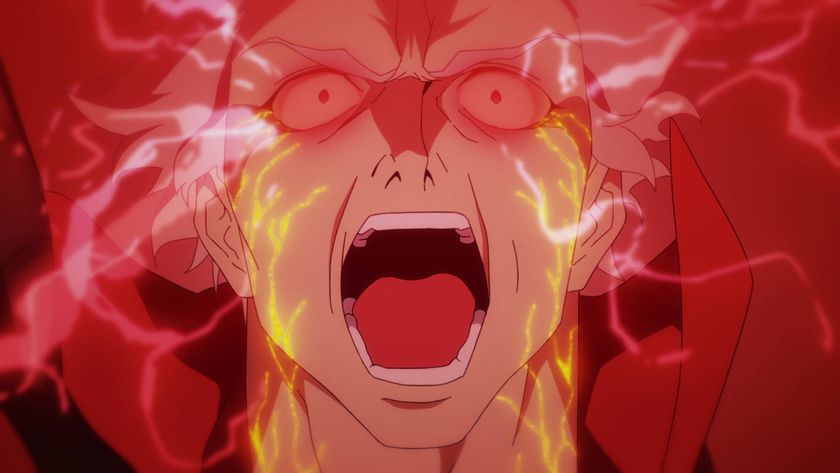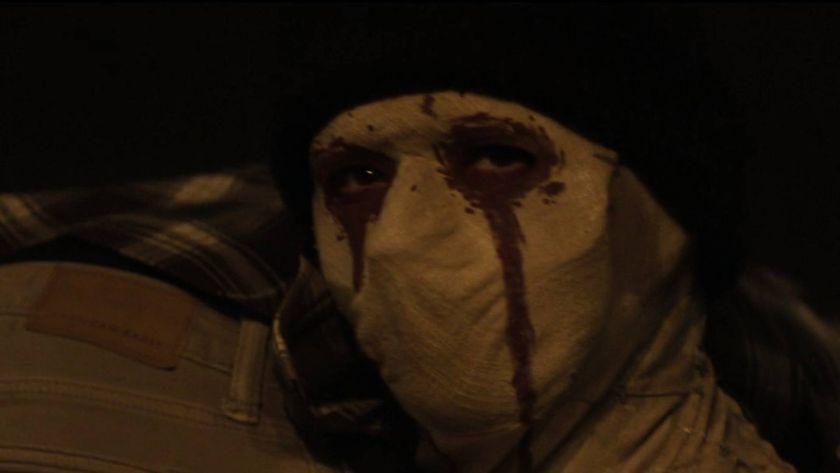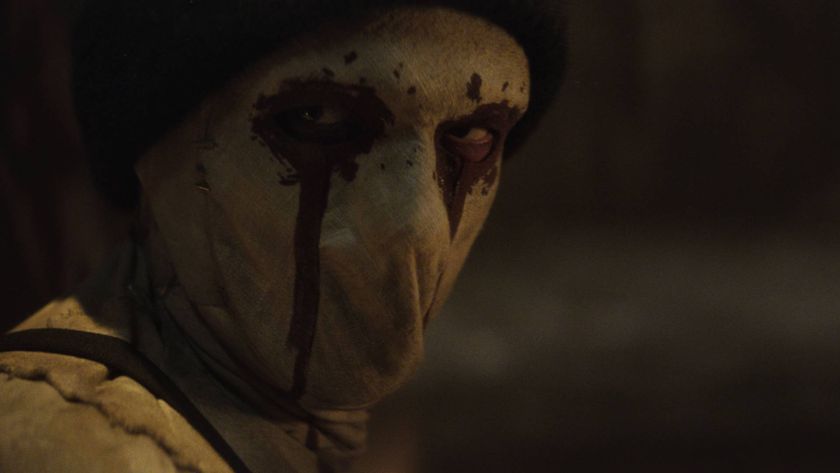Looney Toons
None
17 small-screen 2D cartoon spin-offs from SF franchises
No 3D GGI affairs allowed – good old-fashioned animation only!
1 ATTACK OF THE KILLER TOMATOES: THE ANIMATED SERIES
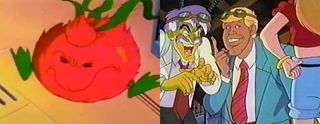
Original broadcast: 1990-1992
Episodes: 21
Bizarrely, we have the Muppet Babies to thank for this show, in a roundabout way. The original movie Attack Of The Killer Tomatoes was a low-budget pastiche of creature features that became a cult favourite, but the follow-up, Return Of The Killer Tomatoes was a long time coming. In fact there weren’t any plans for a sequel at until a mid ’80s episode of the Muppet Babies featured clips from the original film for an episode in which Baby Fozzie Bear fought against the “silly tomatoes”. The episode became a cult hit itself, and the production company behind Muppet Babies, New World, approached the original film’s producers with a financial inducement to make a sequel. That resulted in Return Of The Killer Tomatoes (1988) which became a surprise box office hit. The next (not so) logical step was, clearly, an animated kids’ show based on the film…
The first season of the TV series featured Dr Putrid T Greenberg, voiced by Gomez Addams and The Riddler actor John Astin, basically playing a different version of the same character he had in the films (Mortimer Gangreen). Greenberg wanted to take over the world using his evil tomato henchlings, but two of his failed vegetable experiments escape – Tara Boumdeay, a tomato who looks human, and FT (short for Fuzzy Tomato) who can be passed off as a dog. They team up with the young nephew of a Great Tomato War veteran, Chad Finletter, to defeat Green berg’s nefarious plans. The show was pretty much as zeitgeist-aware as Buffy, lampooning and referencing countless TV shows and films, and even poked fun at its own low-budget roots.
Things changed a bit in season two (allegedly the first US cartoon show to make use of computer animation) when Greenberg actually managed to conquer the world, then went a bit soft and was overthrown by the even more evil Zoltan, formerly one of his tomato elite. Greenberg then teams up with Chad and co to defeat Zoltan. Whereas the first season was a story-of-the-week affair, the second season was far more serialised. And not as much fun.
. .
Sign up to the SFX Newsletter
Get sneak previews, exclusive competitions and details of special events each month!
2 TOXIC CRUSADERS
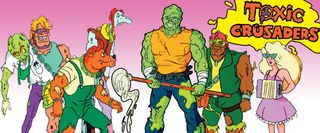
Original broadcast: 1991
Episodes: 13
As if a children‘s cartoon based on Attack Of The Killer Tomatoes weren’t bizarre enough, how about infamous schlock-horror merchants Troma’s efforts to reimagine the R-rated gratuitous sex and violence of the big screen The Toxic Avenger as a child-friendly Saturday morning ’toon show? The 1984 film had seen former school punch bug Melvin Junko transformed into hideously deformed psycho who dealt out bloody revenge to polluting industrial bad guys. In the cartoon Toxie became the leader of a motley bunch of misfit superheroes who fought giant cockroaches. Their MO was still anti-pollution, making them a kind of trailer trash version of The Wombles .
Toxie’s bunch of mutant buddies included: NoZone , a pilot who, after an unfortunate incident involving the Ozone layer developed a powerful sneeze and enormous nose; Junkyard , a dog crossed with a hobo; Headbanger , a two-headed fusion of a mad scientist and a surfer-dude; and Major Disaster , who had the ability to control plants. Mostly rubbish.
.
.
3 SUPERNATURAL: THE ANIMATION
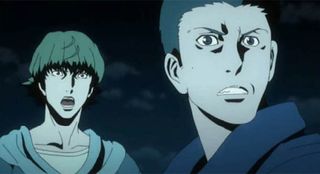
Original release: 2011
Episodes: 22
Okay, hands up, we admit – we haven’t actually seen any full episodes of this yet as it’s only available in Japan (in Japanese) at the moment, but we have checked out as many of the trailers and promos as possible. What we do know is that it’s been made by respected anime producer Madhouse ( Paprika , Paranoia Agent ) and that some of the episodes are remakes of episodes from the first two seasons of the US show (including “Skin”, “Roadkill” and “Home”). The Winchesters in the Japanese version are voiced by the guys who dub the live action show in Japan, but Jensen Ackles and Jared Padalecki will be lending their voices to some of the English language episodes. And while the lead characters are apparently supposed to look like Dean and Sam (allegedly Jared and Jensen signed off the artwork – you can only assume they did so in a darkened room) all the other characters have had a makeover (presumably so the makers didn’t have to negotiate the rights with all the actors involved – nightmare!). And from what we’ve seen, it seems to be about 50% in slow motion.
.
.
4 BACK TO THE FUTURE: THE ANIMATED SERIES
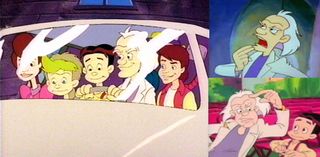
Original broadcast: 1991-1992
Episodes: 26
“Where we’re going we don’t need three dimensions!” Yep Marty McFly, Doc Brown and Clara returned to our screens following the big screen trilogy for a series of animated adventures, although Marty was more a bit-parter this time. The show concentrated instead on the Brown family, which by this time had grown to include sons Jules and Verne. Oh yeah, and Einstein the dog was still around too. Doc has rebuilt the time travelling DeLorean with a handy new feature – it can fold up into a suitcase – but he still used the steam train from BTTF3 on occasion too.
The only members of the film cast to provide vocals for the toon too were Thomas F Wilson (Biff) and, somewhat surprisingly, Mary Steenburgen (Clara), though Christopher Lloyd did appear as Doc Brown in live action segments that topped and tailed each episode. His animated counterpart, however, was voiced by future Homer Simpson, Dan Castellaneta.
.
.
5 GODZILLA/GODZILLA THE SERIES
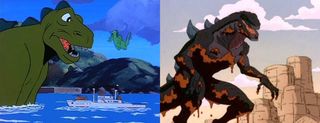
GODZILLA
Original broadcast: 1978-81
Episodes: 26
GODZILLA THE SERIES
Original broadcast: 1998-2000
Episodes: 40
Japan’s favourite giant lizard inspired not one but two animated spin-off, although the second was by way of the much-derided American movie remake.
The ’70s Godzilla has one major problem – Godzooky. In an era awash with annoying animated sidekicks (Snarf, Orco, Slimer, Nono) Godzooky was their evil leader. He was the Jar Jar of the pre-prequel days. He was just awful. Allegedly he was Godzilla’s nephew, though we never get to see a ’Zilla sibling. His mere presence even ruined halfway decent theme tune – one moment there’s a male chorus belting out the word, “Godzilla” like something from Wagner’s The Ring, then suddenly Godzooky gatecrashes his way in accompanied by some ghastly fairground hurdy-gurdy music that could be any worse if they ended it with a comedy spring sound effect. Imagine “Flight Of The Valkyrie” interrupted by “The Birdie Song” and you get the idea.
In the series, Godzilla was the tame pet of a group of scientists who travelled round in a boat called the Calico, who they’d call upon with a high-tech dog whistle whenever they needed help battling some other giant monster. Which they often did. Weekly, in fact. Opponents included a flying manta ray, a Cyclops, a giant jelly fish and the Colossus of Atlantis. None were more scary, though, the episode 14’s Godzooky Clone. Dear Lord, as if one of the blighters weren’t enough.
Godzilla: The Series was a direct follow-up to the 1998 American Godzilla film whose director and producer, Roland Emmerich and Dean Devlin, served as executive producers on the TV show. Arguably, the TV series is far more entertaining, though once again we have a tame Godzilla – actually the only one of the hatchlings from the film to survive, who has been brought up by Dr Nick Tatopoulus. And, just like the earlier TV show, this proves handy, because suddenly the world is full of other giant monsters who need taking down a peg or two. The animation was produced by the same company, Adelaide, who gave us Extreme Ghostbusters and Men In Black: The Series . And it shows.
.
.
6 MEN IN BLACK: THE SERIES
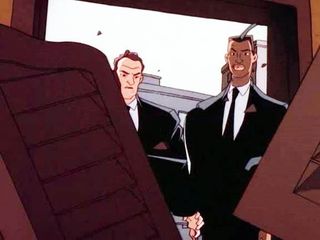
Original broadcast: 1997-2001
Episodes: 53
A pretty by-the-numbers, unremarkable toon remake of the films. The only member the movie cast to make the transition was Tony Shalhoub as Jeebs, but even he only played the part in a few episodes before being replaced. Star Trek Voyager ’s Jennifer Lien provided the voice of Agent Elle, and Adam (Casey) Baldwin was Agent X.
.
.
7 BEETLEJUICE: THE ANIMATED SERIES
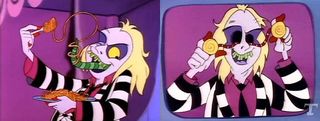
Original broadcast: 1989-1991
Episodes: 109
A show that successfully captured its filmic inspiration in spirit if not in detail (while managing to tone down some of the more malicious and salacious elements of the title character), Beetlejuice: The Series was a huge hit in the States, at one point appearing on two different networks (ABC and Fox) simultaneously. The small screen Beetlejuice was more of a prankster than his malicious big screen counterpart, though he retained the anarchic spirit. In the TV show, he was reinvented as goth girl Lydia’s bestest mate, and while he wasn’t as lustful as his former incarnation, he was insanely jealous of anyone else who seemed to be getting friendly with her (he should see a shrink about that). They would have jolly japes together in the Neitherworld, which was only ever vaguely alluded to as the afterlife and instead just acted as some kind of ersatz Narnia, populated by all kinds of bizarre characters including a skeleton body builder, a tap dancing spider, Scuzzo and Fuzzo the clowns and Doomie the Dragster of Doom, a sentient car. The show’s humour worked on various levels; kids loved the slapstick while adults could enjoy the film and TV injokes.
. .
8 ROBOCOP
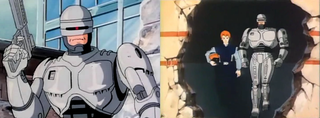
ROBOCOP THE ANIMATED SERIES
Original broadcast: 1998
Episodes: 12
ROBOCOP: ALPHA COMMANDO
Original broadcast: 1998-1999
Episodes: 40
Factoid: RoboCop was a prototype Cylon (the U-86 perhaps?). No, really. In The Animated Series he has a red light in the middle of his visor, and occasionally it even moved side to side.
As you’d expect, there were considerably fewer drugs, expletives and dismembered bodies in this cartoon version than in Paul Verhoeven’s original 1987 film, but the franchise had been steadily becoming more anodyne for a while, through subsequent sequels then on into the dreary live action TV series. The Animated Series substituted lasers for bullets and had a more sci-fi setting, with RoboCop coming up against a barrage of high-tech enemies created by the scheming Dr McNamara.
The Animated Series , however, was positively hard-hitting compared to its successor, Alpha Commando . By this point, Officer Murphy was more Inspector Gadget than RoboCop, equipped with such gadgets as roller skates and a parachute.
.
.
9 BILL AND TED’S EXCELLENT ADVENTURES
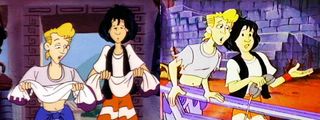
Original broadcast: 1990-1991
Episodes: 21
This one has a bit of a weird production history. Series one was produced by Hanna-Barbera and featured Keanu Reeves and Alex Winter voicing their characters from the film. Series two was produced by a different company, and had new voice actors. But not just any old voice actors. The network broadcasting the show, Fox, was planning a live action Bill and Ted TV show, and so the actors who were contracted to star in that – Evan Richards and Christopher Kennedy – were brought in the voice the animated characters. Was this a cunning ploy to get people used to the new voices? Or simply because they were cheaper?
. .
10 CONAN THE ADVENTURER/CONAN AND THE YOUNG WARRIORS
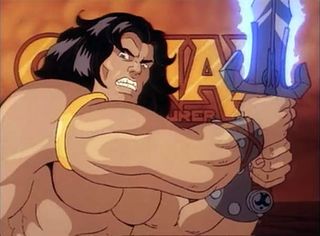
CONAN THE ADVENTURER
Original broadcast: 1992-1993
Episodes: 64
CONAN AND THE YOUNG WARRIORS
Original broadcast: 1994
Episodes: 13
Brought to you by the same company behind My Little Pony , Transformers and GI Joe , Conan The Adventurer turns Robert E Howard’s thieving, killing, womanising barbarian into He-Man’s slightly less camp Cimmerian cousin. It was moderately successful, and had a good run before someone decided it simply wasn’t bland and inane enough, and decided that what Conan really needed was a bunch of kids to train up. And lo, Conan And The Young Warriors was created. And was promptly cancelled.
.
.
11 THE REAL GHOSTBUSTERS/EXTREME GHOSTBUSTERS
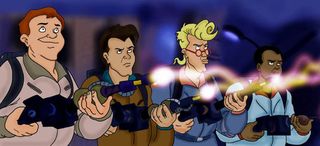
REAL GHOSTBUSTERS
Original broadcast: 1986-1991
Episodes: 147
EXTREME GHOSTBUSTERS
Original broadcast: 1997
Episodes: 40
The show itself was one of the better spin-offs on this list, for the first couple of seasons anyway. None of the actors from the film provided their vocal talents, though Ernie Hudson did audition (presumably he was rejected for reasons other than not being able to do a good Ernie Hudson impression – cost, perhaps?). Bill Murray, meanwhile, complained that his character sounded like Garfield, presumably with his tongue-in-cheek: the voice actor playing his character, Lorenzo Music, was also the voice of Garfield at the time.
Babylon 5 creator J Michael Straczynski was one of the main writers for the first season, and even Trek’s Tribble creator David Gerrold contributed a couple of scripts. But with season three the show changed its title to Slimer And The Real Ghostbusters , as the team’s pet green ghost took a more central role, and the rot started to set in with gaudier, sillier, lighter stories. The show was finally cancelled in 1991 after a creditably long run for a cartoon spin-off (which by their very nature have a built-in obsolescence factor).
But that’s not quite the end of the story. The franchise returned in 1997 – along with many of the same writers from The Real Ghostbusters – in the form of Extreme Ghostbusters . It was basically: Ghostbusters: The Next Generation , with original Ghostbuster Egon Spengler was training up a new team of younger ghostbusters (hang on, isn’t that the plot of Ghostbusters 3 ?) and Slimer was still around, sliming. Question is, if Ghostbusters 3 ever does get made, will there be a new toon to accompany it? There‘s certainly a rich heritage.
. .
12 STARGATE INFINITY
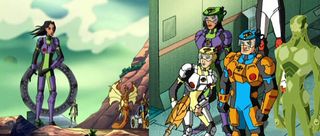
Original broadcast: 2002-2003
Episodes: 26
Poor old unloved Stargate Infinity . Produced without the involvement of anyone from the TV show or the movie, it’s not considered canon by fans nor the live action production team. “I don’t have a problem with it, I’m just not involved,” said SG-1 co-creator Brad Wright, and you can hear the casual dismissiveness in his voice even through the printed word. The show’s not actually so bad, but it does feel completely unnecessary and unconnected to anything else in the Stargate-verse. There are the gates, and erm, that’s about it. It concerns an SG veteran who, when he’s framed for a crime, escapes with his loyal team through a gate. They join up with a few friendly aliens they planet hop, trying to find evidence to clear their names. Ultimately, they’re scuppered by swift cancellation. And being produced by the same company that gave us Care Bears .
. .
13 HIGHLANDER: THE ANIMATED SERIES/
HIGHLANDER: THE SEARCH FOR VENGEANCE
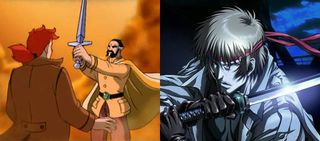
HIGHLANDER: THE ANIMATED SERIES
Original broadcast: 1994-1996
Episodes: 40
HIGHLANDER: THE SEARCH FOR VENGEANCE
Original release: 2007
Episodes: 1 (long one)
After Connor in the film, and Duncan in the TV series, what suitably Scottish sounding name do the producers of the animated Highlander give the latest immortal member of the clan MacLeod? Alastair? Dougal? Hamish? Nope – Quentin. Sorry, any Quentins out there, but even you’ve got to admit, it doesn’t exact conjure up images of tartan warriors.
Quite whether the animated series fits into any Highlander continuity is anyone’s guess, as even the films and the series contradict themselves, so you can hardly get upset if it changes the rules again. And some of those changes are understandable – you can’t see TV networks being happy with a kids’ cartoon hero who goes around beheading people. So in this version of Highlander, Quentin achieves Quickening without killing his opponents – he just grabs their swords to rob them of their powers and immortality. And that’s one of the show’s less major changes.
The series is set in a post-apocalyptic future, where most of the remaining immortals decide to stop warring and live in peace and harmony instead. But there‘s always someone who misses the memo – in this case the evil Kortan. That’s where Quentin comes in – as a new Immortal and descendent of Connor MacLeod who can bypass all that truce nonsense and fight Kortan to the death… It all seems so long ago the mantra for this franchise was, “There can be only one.”
In 2007 Highlander was back in animated form in the anime The Search For Vengeance , which SFX described at the time as “the best version of Highlander since the original movie” and we stick by that statement, though it’s not hard, to be honest. Produced by Madhouse (the same team who are giving us the Supernatural anime), directed by Yoshiaki Kawajiri ( Ninja Scroll , Vampire Hunter D: Bloodlust ) and written by David Abramowitz ( Highlander: The Series , Highlander: The Raven and Highlander: The Source ) it’s a stylish piece of Japanimation that strips back the franchise to its basics. It also has a very striking way of doing the flashback sequences, utilising old-fashioned styles of anime which make a stark contrast to the modern, computer-enhanced graphics of the rest of the movie.
But an old problem still bugs the anime. This time the hero’s called Colin MacLeod.
.
.
14 RETURN TO THE PLANET OF THE APES
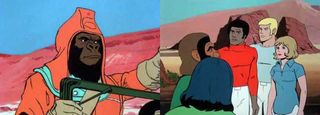
Original broadcast: 1975-1976
Episodes: 13
You might be indignant at the fact that, unlike the primitive societies in the films and the live action Planet Of The Apes TV series, this cartoon seems to go against everything we knew about the future ape society and depict them driving around in cars and watching telly. But, in fact, this was far closer to the ape planet depicted in author Pierre Boulle’s original book. So there.
Shame there’s not much else positive you can say about this cheap looking, short-lived affair from the same people who gave us the animated titles for the Pink Panther films, DePatie-Freleng Enterprises. Yet again, it the story of human astronauts stranded on the future ape-ruled Earth trying not to get captured. Visually it was poor, with some dodgy animation and ropey backgrounds and ill-drawn characters. Even the voice actors sounded bored. There was some fun to be had, though – seeing how far they would go to produce some extremely torturous ape puns, such as William Apespeare and The Apefather.
.
.
15 STAR TREK: THE ANIMATED
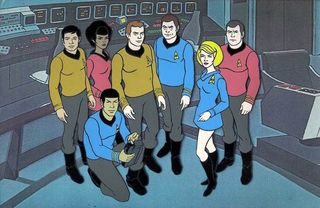
Original broadcast: 1973-1974
Episodes: 22
It’s amazing that it‘s so easy to love Star Trek: The Animated series, considering it was produced by Filmation, a company whose animation was so “economical” they make the cost-cutting tricks used by anime look lavish in comparison: long scenes where nothing moves but the characters’ mouths, a frame rate that seems near to one frame a second, copious re-use of stock footage, heads that flip rather than move from one side to the other.
But that doesn’t matter, because Star Trek: The Animated series has two great things going for it: (most of) the original cast returning for vocal duties and some writing that’s so good, it’s occasionally up to the standard of the series itself. Indeed, the animated series was the first iteration of Trek to win an Emmy. It helped that many of the writers from the original show – including DC Fontana and Marc Daniels – provided scripts. David Gerrold wrote a sequel to his classic episode “The Trouble With Tribbles” called “More Tribble, More Troubles” and the legendary SF author Larry Niven penned “The Slaver Weapon”. Chekov actor Walter Koenig also wrote for the show (“The Infinite Vulcan”) which must have been a consolation for the fact that he was the only member of the original cast who didn’t appear in the animated series – Chekov was cut for budgetary reason and replaced by a female feline creature called M’Ress and long-necked brown alien called Arex.
The show also introduced a holodeck over a decade before Star Trek: The Next Generation was even thought of, and featured a really quaint animated version of the original show’s opening titles. The ever-thrifty Filmation reused characters, backgrounds and even music from Star Trek: The Animated Series for years afterwards in shows such as He-Man , Shazam! and Tarzan .
.
.
16 DOCTOR WHO: THE INFINITE QUEST
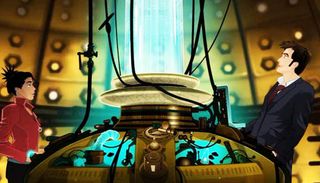
Original broadcast: 2007
Episodes: 13
A bit of a hybrid this one, as it features 2D animation against 3D backdrops, and even the 2D characters were created digitally. But we know if we don’t give it a mention we’ll have a ton of comments asking why we didn’t include it. So, here it is. The 13-part story (each episode a mere three and half minutes long) was aired as part of the CBBC series Totally Doctor Who while the third series of the main show was airing. Animated by Firestep, a company set up by two former Cosgrove Hall employees, it featured the voices of David Tennant (Doctor 10), Freema Agyeman (Martha Jones) and Anthony Head as the main villain, Baltazar. It was fun, but a bit flimsy and lightweight, and nowhere near as good as the fully 3D CG Dreamland a couple of years later.
. .
17 STAR WARS: CLONE WARS
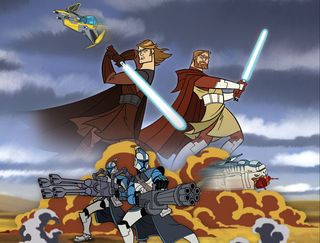
Original broadcast: 2003-2005
Episodes: 25
Right, this list was in particular order, but we have saved our favourite till last. Before the 3D CG Star Wars: The Clone Wars there was this little masterpiece from the creator of Samurai Jack and Dexter's Laboratory creator Genndy Tartakovsky. He brought his unique visual style to the Star Wars universe and created adorably angular versions of the franchise’s iconic characters (you can still see the influence in The Clone Wars ). He also captured the energy and exuberance of the original trilogy in his staccato-edited action sequences. Which was kinda necessary, because for the first two season the episodes were a mere three minutes long. For series three the episodes were extended to 12 minutes, and they were still impressive, but somehow lacked the frenetic energy of the shorter episodes.
Not that it was all action, action, action. Some of the most memorable moments were when Tartakovsky slowed thing down for the kind of impact, tension and imagery Hitchcock would have been proud of: the approach of General Grievous (his first ever screen appearance, predating Revenge Of The Sith ), experienced from the point of view of a group of Jedi trapped during a siege; a pause during a lightsaber battle during which rain starts to fall, the drops fizzing as they hit the laser blades of the Jedi swords. These are moments are animation beauty to cherish.

Dave is a TV and film journalist who specializes in the science fiction and fantasy genres. He's written books about film posters and post-apocalypses, alongside writing for SFX Magazine for many years.
